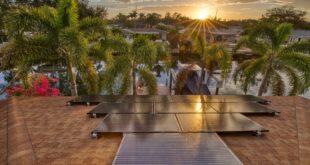The first heat pumps to go through the Department of Energy’s Cold Climate Heat Pump Challenge might be in American homes by the end of the year.
The DOE’s challenge to industry was to build energy efficient, all-electric HVAC units that could perform well in the parts of the US that experience real winters — and buck a stereotype that heat pumps can’t take the cold weather.
Carrier and Lennox announced this week that their newest models, adapted for colder climates, are already rolling off production lines and should be available to consumers in November or December. It’s been just three years since the DOE’s challenge to manufacturers, including two winters of testing in homes across the northern US and Canada. Six other companies are also participating in the challenge, with some heading into their second winter of field testing.
“It’s a huge achievement,” said Ram Narayanamurthy, deputy director of the DOE’s Building Technologies Office. “This is an industry where it normally takes five years or so to get a product from even thinking about it to getting it on the market.”
For now, expect colder climate heat pumps to be on the higher end of the price scale, but government and industry experts say competition and scale should bring down those prices in the next few years.
Why heat pumps struggle in the cold
The name “heat pump” is kind of a misnomer, considering it only covers half of the device’s function. Heat pumps provide both heating and cooling, essentially taking the place of both a furnace and an air conditioner. They work by condensing and transferring thermal energy (heat) from one place to another, moving it outside when you want to cool your home and inside when you want it to warm your home. Your refrigerator uses the same principle.
The problem is that air source heat pumps — those that exchange heat with the air outside — get less efficient as the temperature outside gets further away from that inside. (There are other types like geothermal heat pumps that exchange heat underground.) The current generation of heat pumps tends to struggle as the temperature drops toward 0 degrees Fahrenheit, and really doesn’t work well below zero. That makes them less useful in replacing fossil fuel-powered heating in the northern US and Canada.
The DOE’s challenge to the industry was to advance technology that can overcome that challenge, creating a system that could operate as efficiently at 5 degrees Fahrenheit as it does at 47 degrees Fahrenheit, and that is capable of operating as low as minus-15 degrees Fahrenheit.
“What the DOE has done is provided the support, that is being able to test it in laboratories but also to work with the manufacturers to put it out into the field and test this through two winters,” Narayanamurthy said.
How heat pumps can overcome cold temperatures
The government’s challenge spurred companies to push toward meeting certain specifications and figuring out ways to get units to meet them. Prakash Bedapudi, executive vice president and chief technology officer at Lennox, said the HVAC manufacturer’s engineers stepped up to build test units that used technology from its most efficient heat pumps.
Lennox built its unit to use vapor injection, liquid injection and a variable speed compressor to allow it to extract more heat from the air outside when temperatures drop, Bedapudi said. Vapor injection and liquid injection allow the device to use more refrigerant at once, moving more energy. “It’s kind of like supercharging your car engine,” he said. A variable-speed compressor allows the heat pump to cycle that refrigerant through more quickly when the temperature is colder.
Carrier also used a variable speed compressor that can operate more effectively in colder temperatures, said Michael Carter, Carrier’s associate director of residential outdoor product management. In combination with new refrigerants and other changes, Carter said Carrier’s device is as efficient at 5 degrees as it would be at 47 degrees, and can continue to operate as low as minus-23 degrees (although not as efficiently).
“One of the things this does for consumers is it gives them the opportunity to invest in a heat pump that provides the ultimate amount of heat at those temperatures, reducing the time or the need they may have to switch over to a backup heat source,” Carter said.
From the laboratory to the home
The first step of the challenge was laboratory testing at DOE’s Oak Ridge National Laboratory. Once the devices proved capable in the lab, they moved into the field to see if they actually worked as expected. Heat pumps were installed at homes in several cold US states and in Canada through tests assisted by DOE’s Pacific Northwest National Laboratory.
“It is literally in somebody’s house,” Narayanamurthy said.
The tests taught manufacturers about their equipment. The Carrier heat pump required more airflow than some of the test homes’ ductwork was capable of handling, Carter said. That may be an issue when trying to retrofit an existing home, but it isn’t a concern for newly constructed homes, which can be designed with the ductwork needed.
Now manufacturers are starting to produce heat pumps for consumers. Lennox expects to have units available for sale in November, while Carrier expects to start sales in December.
A higher price for a better heat pump
One downside is that these units will cost more than standard heat pumps, which already cost a bit more than central air conditioners. While prices vary depending on region, installer and more, both Lennox and Carrier said they expect prices to be in line with or somewhat more than their current top-of-the-line models, which cost several thousand dollars.
“Our challenge is, how do we drive the cost down?” Bedapudi said.
The DOE’s intent with the challenge was to encourage the entire industry to start building these models and innovating so they can compete with each other. “What we are trying to build out is an expanded market,” Narayanamurthy said. With time, the DOE hopes the costs of components will drop and cold-climate heat pumps will be more cost competitive.
It’s worth noting that a big component of the cost of installing a heat pump doesn’t come from the device itself, but from the work of connecting it to your home. That might include ductwork, electrical work or other costs not included in the thousands of dollars for the unit itself. But all of that is also eligible for tax credits and rebates from the federal Inflation Reduction Act and other incentives for clean energy technologies. The federal tax credit would cover 30% of the cost of a heat pump installation, up to a cap of $2,000. Other rebates might be available from states.
 synnbiob
synnbiob


